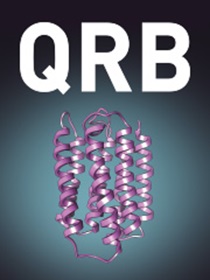离子在水中的行为受其亲水性控制
IF 5.3
2区 生物学
Q1 BIOPHYSICS
引用次数: 29
摘要
库仑定律所描述的强的、远距离的静电力对离子在水中消失了,而这些离子的行为是由它们的亲水性控制的——一种由它们的电荷密度产生的弱的、短程的力。这是在20世纪80年代中期通过仔细校准的Sephadex®G-10(测量有效体积,从而测量离子的亲水性)和同位素取代的中子衍射(测量衍射离子附近水分子的密度和取向,从而测量其亲水性)通过实验建立的。这些结论最近得到了分子动力学模拟的证实,该模拟明确地模拟了每个单独的水分子。这种令人惊讶的力的变化发生是因为盐水溶液中带相反电荷的离子以离子对的形式存在(由0,1或2个水分子分开),这已经被介电弛豫光谱所证明;这抵消了强大的远程静电力,使弱的、近距离的亲水性效应脱颖而出。利用宏观介电常数的模型无法捕捉到盐水溶液的这种微观结构。此外,1997年和2004年首次描述的匹配亲水性定律(Law of Matching Water Affinity)表明,接触离子对的形成是由亲水性控制的,并且是带电物质溶解度的主要决定因素,因为只有净中性物质才能改变相。本文章由计算机程序翻译,如有差异,请以英文原文为准。
The behavior of ions in water is controlled by their water affinity
Abstract The strong, long-range electrostatic forces described by Coulomb's law disappear for ions in water, and the behavior of these ions is instead controlled by their water affinity – a weak, short-range force which arises from their charge density. This was established experimentally in the mid-1980s by size-exclusion chromatography on carefully calibrated Sephadex® G-10 (which measures the effective volume and thus the water affinity of an ion) and by neutron diffraction with isotopic substitution (which measures the density and orientation of water molecules near the diffracting ion and thus its water affinity). These conclusions have been confirmed more recently by molecular dynamics simulations, which explicitly model each individual water molecule. This surprising change in force regime occurs because the oppositely charged ions in aqueous salt solutions exist functionally as ion pairs (separated by 0, 1 or 2 water molecules) as has now been shown by dielectric relaxation spectroscopy; this cancels out the strong long-range electrostatic forces and allows the weak, short-range water affinity effects to come to the fore. This microscopic structure of aqueous salt solutions is not captured by models utilizing a macroscopic dielectric constant. Additionally, the Law of Matching Water Affinity, first described in 1997 and 2004, establishes that contact ion pair formation is controlled by water affinity and is a major determinant of the solubility of charged species since only a net neutral species can change phases.
求助全文
通过发布文献求助,成功后即可免费获取论文全文。
去求助
来源期刊

Quarterly Reviews of Biophysics
生物-生物物理
CiteScore
12.90
自引率
1.60%
发文量
16
期刊介绍:
Quarterly Reviews of Biophysics covers the field of experimental and computational biophysics. Experimental biophysics span across different physics-based measurements such as optical microscopy, super-resolution imaging, electron microscopy, X-ray and neutron diffraction, spectroscopy, calorimetry, thermodynamics and their integrated uses. Computational biophysics includes theory, simulations, bioinformatics and system analysis. These biophysical methodologies are used to discover the structure, function and physiology of biological systems in varying complexities from cells, organelles, membranes, protein-nucleic acid complexes, molecular machines to molecules. The majority of reviews published are invited from authors who have made significant contributions to the field, who give critical, readable and sometimes controversial accounts of recent progress and problems in their specialty. The journal has long-standing, worldwide reputation, demonstrated by its high ranking in the ISI Science Citation Index, as a forum for general and specialized communication between biophysicists working in different areas. Thematic issues are occasionally published.
 求助内容:
求助内容: 应助结果提醒方式:
应助结果提醒方式:


